Bulletin – September 2007 Immigration and Labour Supply[1]
- Download 60KB
Introduction
The expansion of the Australian economy over the past 15 years has been associated with strong employment growth. One important source of labour supply over this period has been from immigration, which in recent years has made its largest contribution to growth of the civilian population (aged 15 years and over) since at least 1980. This article looks at the labour market activity of newly arrived immigrants in recent years and documents the significant increase in employment of immigrants, which is likely to reflect both the higher proportion of immigrants entering through the Skill Stream programme in recent years and the general strength of the labour market.
Immigration in Australia
Australian immigration can be broadly divided into permanent and temporary categories. Within the permanent visa category, immigrants can enter Australia under the Migration Programme, or with a visa for New Zealand settlers or a Humanitarian visa (Table 1).
| Permanent | 180,861 | Temporary | 3,978,420 |
|---|---|---|---|
| Migration Programme | Non-business visitors(b) | 3,195,039 | |
| – Skill Stream | 97,340 | Business visitors | 368,333 |
| – Family Stream | 45,290 | Student | 190,674 |
| – Special Eligibility Stream | 310 | Working Holiday Makers | 111,973 |
| Others | Business (Long Stay) | 71,150 | |
| – NZ settlers(a) | 23,781 | Others(c) | 41,251 |
| – Humanitarian | 14,140 | ||
|
(a) Estimated by permanent arrivals of NZ citizens Source: Department of Immigration and Citizenship |
|||
The Migration Programme largely comprises the Skill and the Family Streams, which together accounted for nearly 80 per cent of permanent immigration in 2005/06. The rise in visas granted under the Migration Programme since the 1990s has primarily come from the Skill Stream category, with Family Stream visas having increased only slightly. In the early 1980s the number of Family Stream visas was around four times that of Skill Stream visas but in recent years more than twice as many visas were granted in the Skill Stream compared with the Family Stream (Graph 1). New Zealand settlers are the next largest group of permanent immigrants, comprising over 13 per cent of the permanent immigrant category.
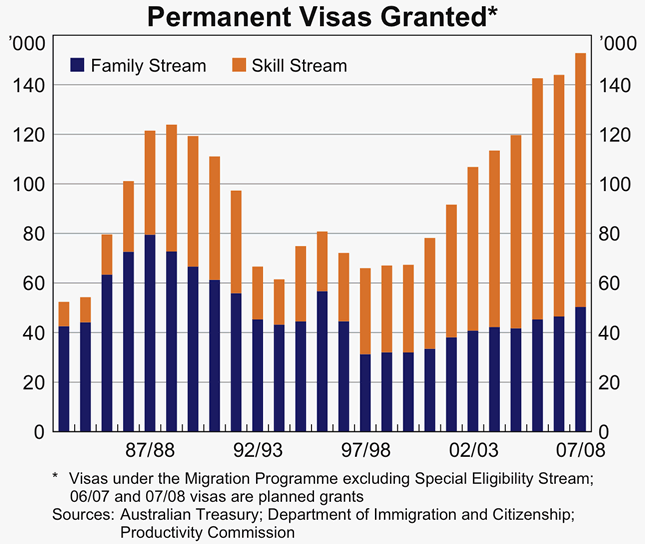
In the temporary visas category, the main groups contributing to the labour market are likely to be Working Holiday Makers (subclass 417) and Business (Long Stay) visitors (subclass 457). These two categories accounted for around 200,000 visas granted in 2005/06, and just over 143,000 immigrants in these categories were present in Australia in June 2006 (Graph 2).
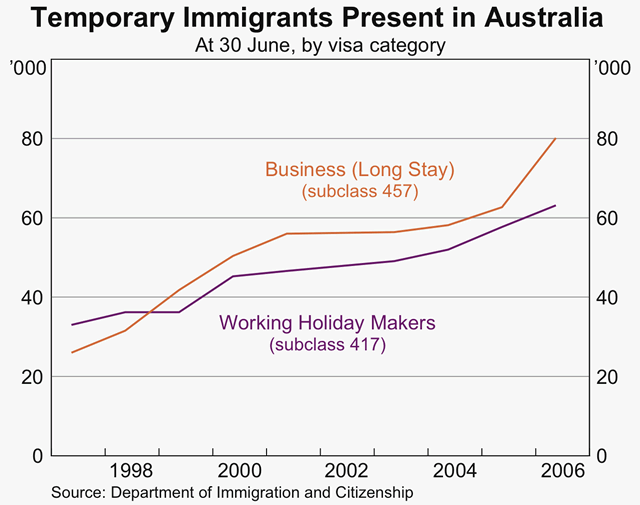
Over the past decade, the number of working holiday makers coming to Australia has increased substantially; between 1995/96 and 2005/06, the number of working holiday visas granted in each financial year almost tripled. However, there is a frequent turnover of working holiday makers (as they can stay only for a maximum of 12 months in Australia). As a result, only the annual change in their total number present in Australia at a specific point in time will contribute to employment growth; this change has typically been equivalent to less than 2 per cent of annual employment growth.[2] In recent years, work restrictions for this visa category have been relaxed, pointing towards a potentially increasing labour market contribution from this group.
Similarly, there will also be turnover in Business (Long Stay) visa holders, who can stay between three months and four years. However, it appears that the majority of these visa holders stay for more than a year and therefore are more likely to participate in the labour market over an extended period. Consistent with this, in June 2006 there were more holders of Business (Long Stay) visas than working holiday makers present in Australia, although the number of visas issued was much larger for working holiday makers during the 2005/06 financial year. The annual change in Business (Long Stay) visa holders present in Australia has typically been equivalent to less than 4 per cent of annual employment growth.
Labour Market Performance of Immigrants
Unpublished data from the Labour Force Survey (LFS) of the Australian Bureau of Statistics can be used to shed light on the labour market performance of immigrants in the first few years after their arrival. Since the LFS covers only persons who report that they are in Australia for more than 12 months, working holiday makers are unlikely to be included in these data. Some proportion of the Business (Long Stay) visitors will be included in the data, but the bulk of recent immigrants captured in the LFS will be permanent migrants, a category which is largely made up of the Family and Skill Streams.
The trends in the number of new immigrants estimated from the LFS are broadly consistent with the trends in permanent visas granted. The number of migrant arrivals tends to move with the business cycle, with the most recent trough having been reached around the time of the early 1990s recession (Graph 3). Since 1994, the number of immigrants arriving in Australia has steadily increased. Estimated migrant arrivals in 2006 were at their highest since at least 1979, both in numbers and as a proportion of the civilian population (aged 15 years and over).
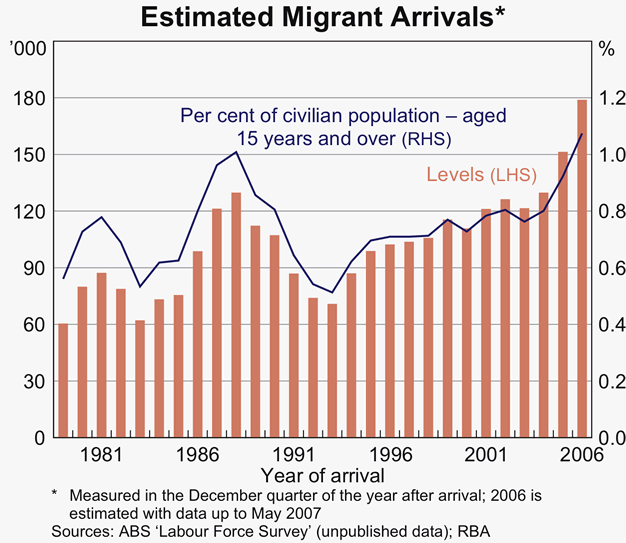
Increasing contribution to employment growth
In line with the growth in arrivals, the number of new immigrants who are employed is currently at its highest level since 1979, the period for which we have data. Migrant arrivals – defined as those who arrived in the current or previous year – have been making a relatively large contribution to total employment growth in recent years (Graph 4). Between 2001 and 2006, new immigrants accounted for about 30 per cent of employment growth, compared with an average of around 25 per cent over the previous 20 years.[3]
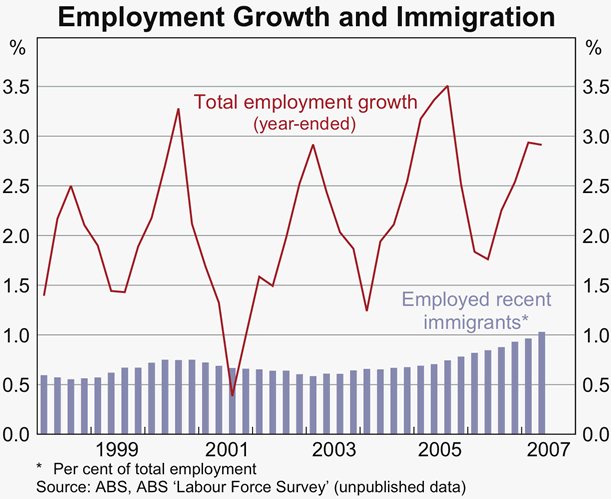
Decline in the unemployment rate of immigrants
Recent immigrants, surveyed in the year after their arrival, are experiencing their lowest unemployment rate since at least 1980. While in the year after arrival the immigrant unemployment rate is consistently higher than the national unemployment rate, in recent years this gap has narrowed significantly. The unemployment rate of recently arrived immigrants has broadly followed the national unemployment rate, although it has been more sensitive to changes in demand for labour over the business cycle (Graph 5). Specifically, the peaks in the immigrant unemployment rate in the early 1980s and early 1990s coincided with unfavourable labour market conditions; in the 1990s recession, the unemployment rate of newly arrived immigrants reached a peak of over 30 per cent in the year after arrival.
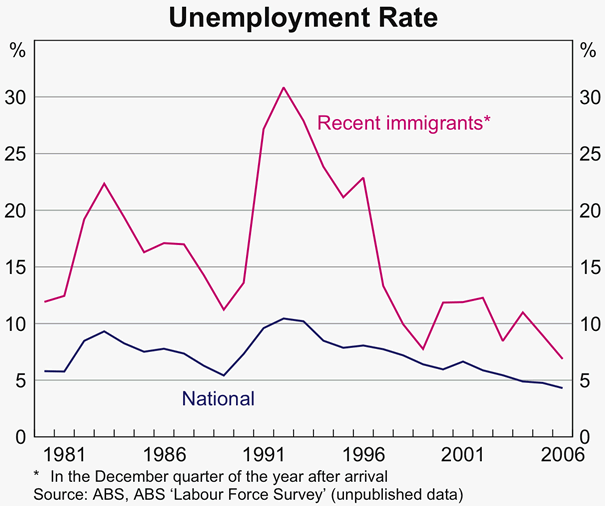
The unemployment rate of immigrants tends to decrease the longer they stay in Australia (Graph 6). Within only a short period, the unemployment rate falls sharply, and immigrants’ unemployment rates are lower by 5 to 10 percentage points in the year after arrival compared with the year they arrived. Looking beyond the first one to two years after arrival, the gap between the national unemployment rate and immigrant unemployment continues to narrow. By the time a cohort has been in Australia for three to four years, their unemployment rate falls to levels close to the national unemployment rate.
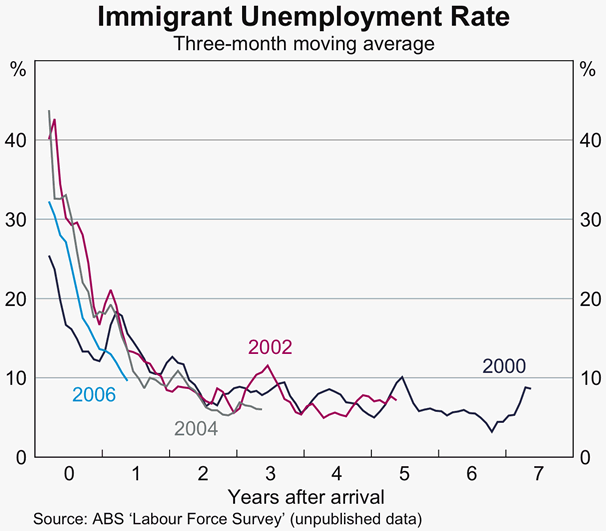
Increase in labour force participation
In recent years, immigrants have also been increasingly likely to participate in the labour force, with the participation rate of the 2006 cohort above that of earlier cohorts (Graph 7). Although participation rates are initially quite low in the first few months as new immigrants settle, they tend to increase quite rapidly. For example, immigrants arriving over 2000–2005 now have participation rates above the national level. With immigrants relatively more concentrated in the prime working-age group, it may not be surprising that they have participation rates above the national average.[4]
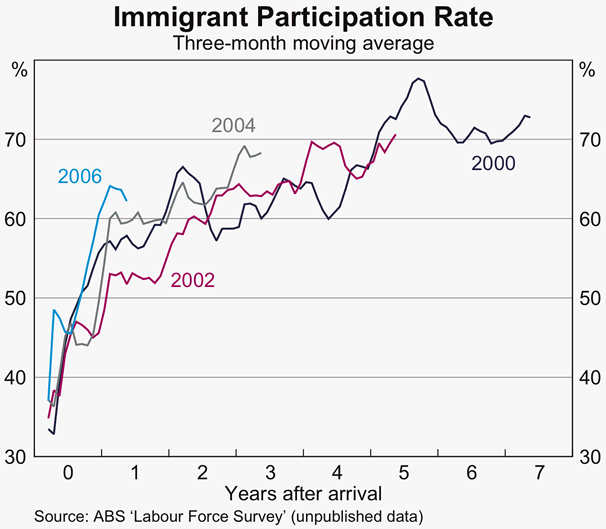
Immigration varies by state
Western Australia, which has experienced strong employment growth in recent years, has received a disproportionate share of new arrivals relative to its population. In 2006 and 2007, immigrant arrivals in this state have been running at an annual rate equivalent to 1.7 per cent of the Western Australian population, compared with 1.1 per cent nationwide (Table 2). The demand for immigrant workers in Western Australia and its attractiveness to immigrants is not surprising given the strength of its labour market in recent years.
| NSW | Vic | Qld | SA | WA | Australia | |
|---|---|---|---|---|---|---|
| 2006–2007 arrivals | ||||||
| Working-age arrivals (‘000), annualised |
57.9 | 46.2 | 35.5 | 10.7 | 28.9 | 186.2 |
| Share of population (%)(a) | 1 | 1.1 | 1.1 | 0.8 | 1.7 | 1.1 |
| Unemployment rate (%) | 12 | 20.7 | 10.6 | 24.6 | 7.7 | 13.1 |
| Participation rate (%) | 62.4 | 54.2 | 58.8 | 46.0 | 73.0 | 60.0 |
| 2001–2005 arrivals | ||||||
| Working-age arrivals (‘000), annualised |
43.4 | 30.5 | 20.6 | 6.3 | 14.4 | 118.3 |
| Share of population (%)(a) | 0.8 | 0.8 | 0.7 | 0.5 | 0.9 | 0.7 |
| Unemployment rate (%) | 4.2 | 5.9 | 4.6 | 10.8 | 3.3 | 4.9 |
| Participation rate (%) | 66.1 | 67.0 | 75.0 | 64.1 | 70.4 | 68.2 |
|
(a) Per cent of average population during arrival period Source: ABS |
||||||
The tight labour market conditions in Western Australia have also helped integrate immigrants into the labour market, with the immigrant labour force participation rate for those that arrived in 2006 and 2007 being the highest in that state. Similarly, the unemployment rate for recent immigrants settling there was lower than in other states; the unemployment rate for 2001–2005 immigrants in Western Australia was 3.3 per cent, compared with the national average of 4.9 per cent.
Conclusions
Immigration has historically been an important source of labour supply for Australia. This has continued into the most recent period, when immigrants have accounted for a considerable proportion of employment growth in a historically tight labour market. This presumably reflects both the increase in the number of immigrants and the growing share arriving under the Skill Stream migration programme. As a result of the strong labour market and the changing mix of immigrants, participation rates of recent immigrants have risen to high levels and their unemployment rate is at its lowest level since at least 1980.
Footnotes
This article was prepared by Wing Hsieh and Marion Kohler of Economic Analysis Department. [1]
Further analysis of the labour market impact of these workers is limited by data availability. Harding and Webster (2002), ‘The Working Holiday Maker Scheme and the Australian Labour Market’, Melbourne Institute of Applied Economic and Social Research, September, estimate that an intake of around 80,000 working holiday makers amounted to a net contribution of around 30,000 full-time equivalent positions at the time of their survey of working holiday makers in 2000. [2]
The overall effect of migration on employment growth is likely to be lower, since emigration can detract from employment growth. Due to data availability, this article concentrates on immigration rather than net migration. [3]
See Productivity Commission (2006), ‘Economic Impacts of Migration and Population Growth’, Final Report, April, p xxvi. [4]